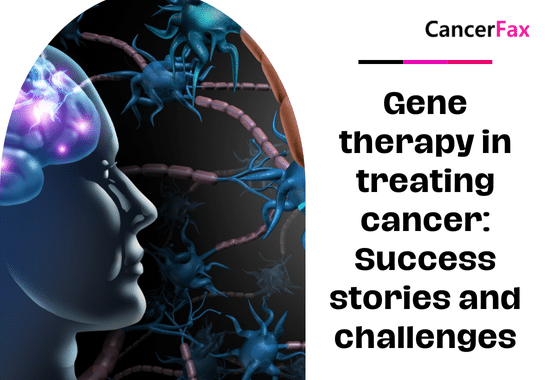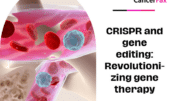Gene therapy in treating cancer: Success stories and challenges
Gene Therapy
Gene therapy is such a fast-growing field with enormous potential for the treatment of this disease by targeting genetic mutations that cause it. Gene therapy not only provides new ways of manipulating the genetic material of cancer cells but also increases the immune response of the body against cancer. It has been a difficult journey, with remarkable successes and significant challenges.
The Promise of Gene Therapy in Cancer Treatment
Gene therapy is applied to correct or replace genes with certain faults, prevent oncogene expression, or enhance the body’s natural defenses against cancer. Techniques include:
Gene Replacement Therapy: Introduce functional genes into a cell to replace mutated genes.
Gene Silencing: Extinction of oncogenes with the help of RNAi or antisense oligonucleotides.
Suicide Gene Therapy: Introduction of genes that will convert certain non-toxic prodrugs into toxic drugs within cancer cells.
Immunotherapy Enhancement: Genetic alteration of immune cells, such as T cells, to better recognize and attack cancer cells.
Gene Therapy for Cancer Success Stories
CAR-T Cell Therapy:
Chimeric Antigen Receptor T-cell therapy has revolutionized the treatment mechanism for certain blood cancers, especially acute lymphoblastic leukemia and diffuse large B-cell lymphoma. The genetic alteration makes receptors in CAR-T cells that are specific to cancer cells, allowing only the targeting of such cells.
Example: Novartis developed Kymriah, the first FDA-approved CAR-T therapy for pediatric and young adult patients with refractory or relapsed ALL. It showed impressive overall remission rates in clinical trials and proved to be a hope-giving drug to such patients who have very dim prospects of surviving the disease. Oncolytic Virus Therapy: Oncolytic viruses are genetically modified for selective infection and killing of cancer cells, thereby provoking an immune response against the tumor.
Example: T-VEC, the FDA-approved talimogene laherparepvec oncolytic virus for melanoma, is an improved herpes simplex virus that targets and destroys cancer cells. It has been demonstrated that T-VEC shrinks tumors and can improve overall survival rates.
Gene Editing in the Treatment of Cancer:
The opportunities offered by the CRISPR-Cas9 technology in directly targeting and correcting genetic mutations in cancer cells have unfolded new avenues.
Example: In 2019, Chinese researchers performed the first-ever human trial using CRISPR to edit T cells in patients suffering from lung cancer. The edited T cells were designed for improved immune response against this cancer and preliminary results are encouraging so far.

Pic: Gene therapy in treating cancer: Success stories and challenges
Challenges and Hurdles
Methods of Delivery:
Still, there is a challenge in effectively ensuring targeted delivery of therapeutic genes doses. Though the viral vectors are efficient to some extent, they provoke immune responses or cause insertional mutagenesis. Nowadays, research has focused on non-viral delivery strategies, and nanoparticles are one among them, which requires optimization procedures.
Safety Issues:
The potential for adverse immune reactions and off-target effects, as well as long-term safety, is also a concern. This was evidenced dramatically by the 1999 death of Jesse Gelsinger, a subject involved in a gene therapy trial, in which negligent practices in safety measures and follow-up are believed to have played a role.
Resistance Mechanisms:
Since the patient’s tumor cells are capable of resisting gene therapy, combination approaches are always necessary, requiring ongoing monitoring for the adoption of some other treatment modalities.
Cost and Accessibility:
Gene therapies are very expensive, and so access by many patients is limited. Equitable access and reduced high development and treatment costs are critical to its wide adoption.
Future Directions
Personalized Medicine:
Genomics advances and bioinformatics drive the future of personalized gene therapies. It gives customized treatment according to an individual’s genetic profile, which enhances efficacy and minimizes side effects.
Combo Therapies:
Gene therapy combined with other modalities of treatment—like chemotherapy, radiation, or immunotherapy—might form a way of getting around the resistance and attaining all-inclusive control over these cancers.
Improved Delivery Systems:
Other developments underway include much safer and more efficient delivery systems devised with the inclusion of viral vectors and non-viral systems like lipid nanoparticles. These developments will make gene therapy more focused and safe.
Regulatory and Ethical Issues:
For gene therapy to progress, bioethical concerns will have to be addressed, and meanwhile, robust regulatory frameworks will have to be built. The hallmarks of the responsible development of gene therapy shall include informed consent, long-term follow up, and access to treatment.
Conclusion
Gene therapy has already promised much in cancer treatment,, giving new hope to patients where conventional treatment techniques have failed. Success stories, such as CAR-T cell therapy and oncolytic virus therapy, unequivocally establish the transformative ability of genetic approaches.
Delivery methods, safety considerations, and high costs are the hurdles that must be overcome in gene therapy in oncology. With newer technologies and refined research, gene therapy is already assuming center stage in cancer therapy and is opening new vistas into the era of precision medicine and personalized care.
References:
- CAR-T Cell Therapy:
- Maude, S.L., Frey, N., Shaw, P.A., Aplenc, R., Barrett, D.M., Bunin, N.J., … & Grupp, S.A. (2014). Chimeric Antigen Receptor T cells for sustained remissions in leukemia. New England Journal of Medicine, 371(16), 1507-1517. doi:10.1056/NEJMoa1407222.
- Oncolytic Virus Therapy:
- Andtbacka, R.H., Kaufman, H.L., Collichio, F., Amatruda, T., Senzer, N., Chesney, J., … & Puzanov, I. (2015). Talimogene laherparepvec improves durable response rate in patients with advanced melanoma. Journal of Clinical Oncology, 33(25), 2780-2788. doi:10.1200/JCO.2014.58.3377.
- CRISPR-Based Cancer Trials:
- Lu, Y., Xue, J., Deng, T., Zhou, X., Yu, K., Deng, L., … & Yin, H. (2020). Safety and feasibility of CRISPR-edited T cells in patients with refractory non-small-cell lung cancer. Nature Medicine, 26(5), 732-740. doi:10.1038/s41591-020-0840-5.
- Delivery Methods Challenges:
- Yin, H., Kauffman, K.J., & Anderson, D.G. (2017). Delivery technologies for genome editing. Nature Reviews Drug Discovery, 16(6), 387-399. doi:10.1038/nrd.2016.280.
- Safety Concerns:
- Marshall, E. (2000). Gene Therapy on Trial. Science, 288(5468), 951-957. doi:10.1126/science.288.5468.951.
- Resistance Mechanisms:
- Holohan, C., Van Schaeybroeck, S., Longley, D.B., & Johnston, P.G. (2013). Cancer drug resistance: an evolving paradigm. Nature Reviews Cancer, 13(10), 714-726. doi:10.1038/nrc3599.
- Cost and Accessibility:
- Mullin, E. (2019). The gene therapy revolution is here. Can we afford it? MIT Technology Review. Retrieved from https://www.technologyreview.com/2019/02/01/103546/gene-therapy-revolution-cost/.
- Personalized Medicine:
- Collins, F.S., & Varmus, H. (2015). A new initiative on precision medicine. New England Journal of Medicine, 372(9), 793-795. doi:10.1056/NEJMp1500523.
- Combination Therapies:
- Postow, M.A., Callahan, M.K., & Wolchok, J.D. (2015). Immune checkpoint blockade in cancer therapy. Journal of Clinical Oncology, 33(17), 1974-1982. doi:10.1200/JCO.2014.59.4358.
- Improved Delivery Systems:
- Loo, Y.L., & Shen, H. (2012). Nanomedicine: nanomaterials for therapeutic delivery. Current Opinion in Biotechnology, 23(6), 889-894. doi:10.1016/j.copbio.2012.01.019.
Susan Hau is a distinguished researcher in the field of cancer cell therapy, with a particular focus on T cell-based approaches and cancer vaccines. Her work spans several innovative treatment modalities, including CAR T-cell therapy, TIL (Tumor-Infiltrating Lymphocyte) therapy, and NK (Natural Killer) cell therapy.
Hau's expertise lies in cancer cell biology, where she has made significant contributions to understanding the complex interactions between immune cells and tumors.
Her research aims to enhance the efficacy of immunotherapies by manipulating the tumor microenvironment and exploring novel ways to activate and direct immune responses against cancer cells.
Throughout her career, Hau has collaborated with leading professors and researchers in the field of cancer treatment, both in the United States and China.
These international experiences have broadened her perspective and contributed to her innovative approach to cancer therapy development.
Hau's work is particularly focused on addressing the challenges of treating advanced and metastatic cancers. She has been involved in clinical trials evaluating the safety and efficacy of various immunotherapy approaches, including the promising Gamma Delta T cell therapy.
- Comments Closed
- July 17th, 2024






Cancer gene therapy, Cancer treatment challenges, CAR-T success stories, Gene editing for cancer, Gene therapy clinical trials, Genetic engineering in oncology, Immunotherapy breakthroughs, Precision oncology advances
🌟 Welcome to Beijing Biotech! 🌟
Thank you for reaching out! We are dedicated to transforming lives through advanced gene therapy solutions for sickle cell disease and thalassemia. Our team is committed to delivering cutting-edge treatments, personalized care, and support on every step of your journey to better health.
Please feel free to ask any questions or let us know how we can assist you. Together, we’re here to make a difference.
Warm regards,
The Beijing Biotech Team